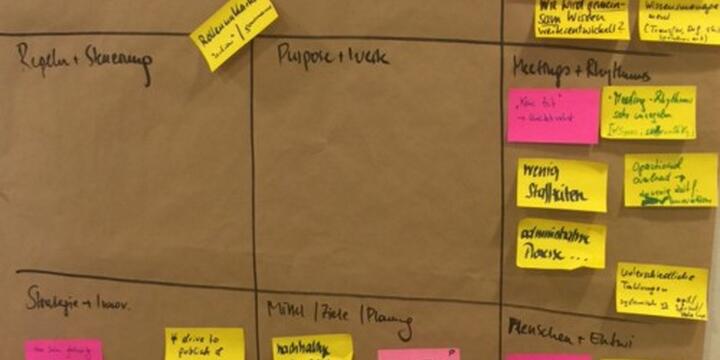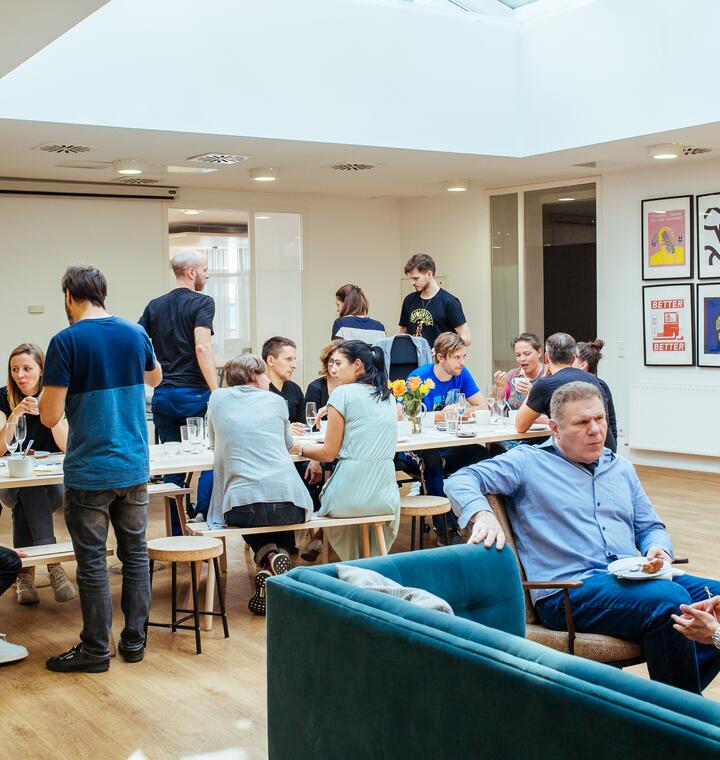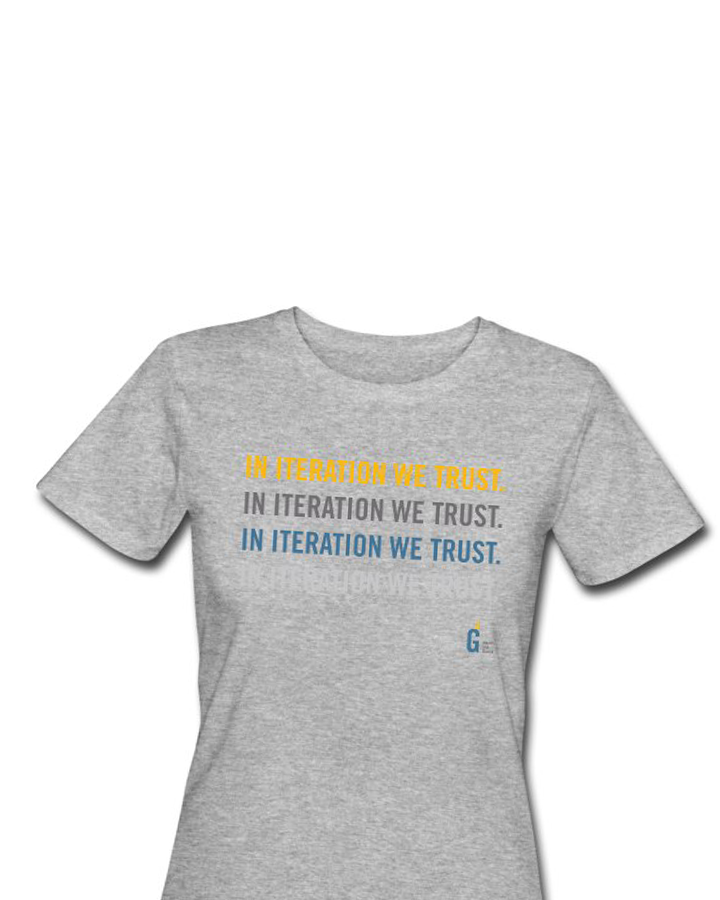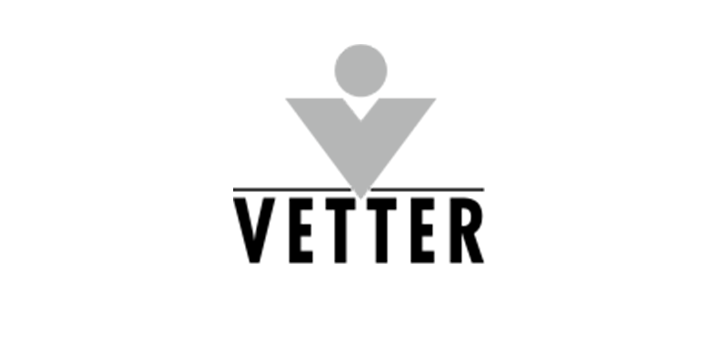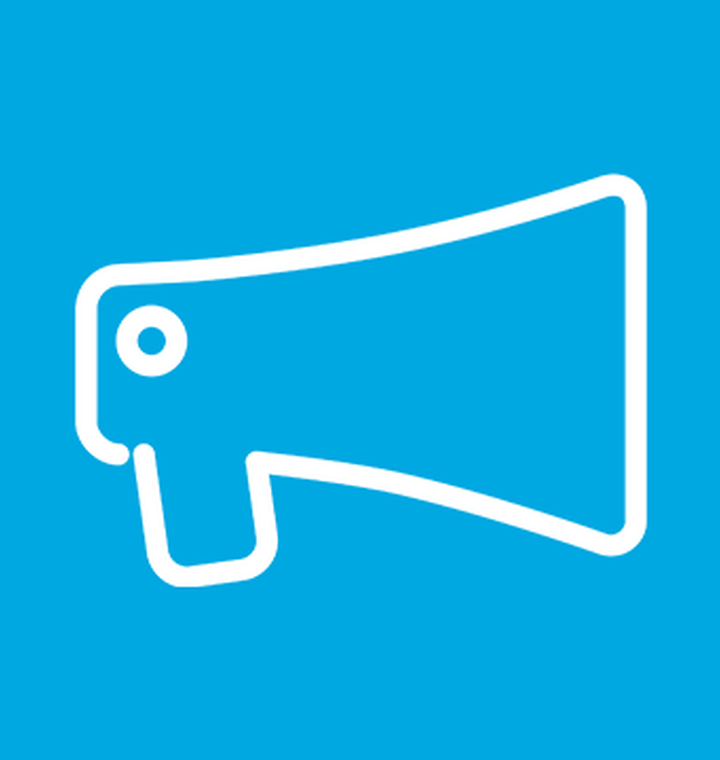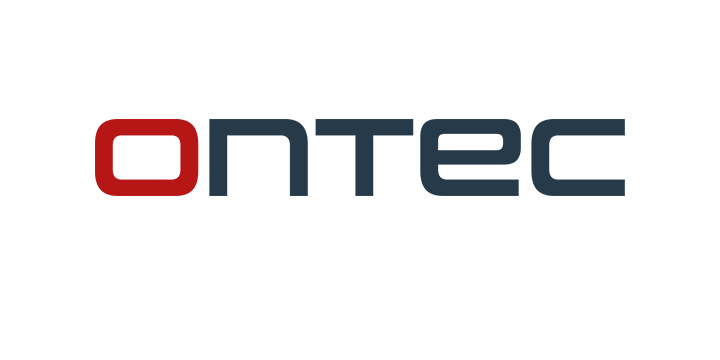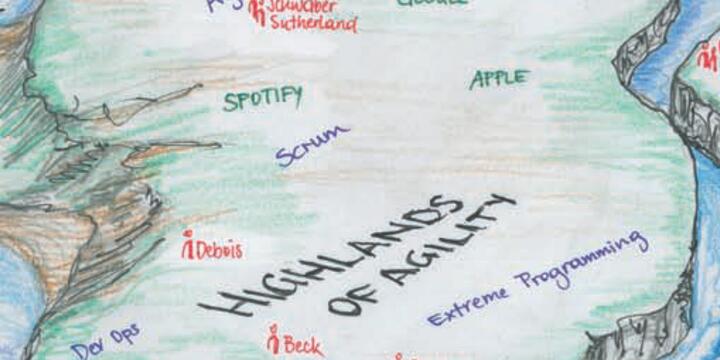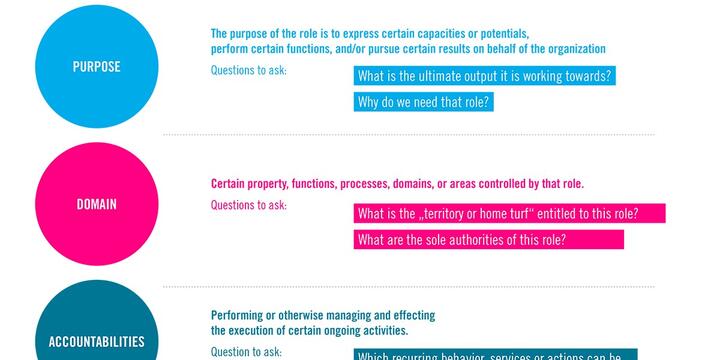Death by Too Many Great Ideas
(c) Stefan Cosma, Unsplash
Imagine a flock of birds moving in effortless elegance. It appears to be a living organism that swiftly changes direction. Every single bird aligns with the flock, without a central commander. That is the ideal of self-organization we envisioned for ourselves when we founded dwarfs and Giants in 2015 with a team of 4. Our reality in 2019, with 25 people, was quite different.
Like us, many organizations struggle to establish strategic alignment when they scale. Some focus on keeping tight alignment but loose entrepreneurial spirit on the way. Others focus on keeping creative freedom but become scattered and overwhelmed. We belong to the latter group. We run on Holacracy since the beginning and designed our legal setup to reflect our values of working together as partners on eye-level. So, in 2019, we suffered from “excellent idea overload”. There were too many options for client projects, product development and internal initiatives.
More companies die of indigestion than starvation.
David Packard
We noticed painful delays in the progress of our strategic initiatives. Our calendars and internal days were packed and many of us felt overwhelmed. We knew something had to change. In this article, you’ll learn what we did to counteract this problem, what went well and what didn’t. We will also share what you can do to manage the tension between alignment and creative freedom.
Alignment in Holacracy Organizations — Three Guiding Principles
Luckily, we didn’t start from scratch. There were some tools for alignment we could build on: Purpose, strategic rules of thumb and special roles that take care of prioritization.
Our primary reference point for alignment as an organization is our purpose. “Rewriting the future of organization. Catalyzing the evolution of wholesome organizations.” We discuss it regularly in our operational meetings and we make decisions on projects and investments based on our purpose.
Holacracy organizations are composed of roles and circles: A circle is something like a team (but not quite) and people in the organization can fill roles in different circles. Each circle creates strategic rules of thumb. For an example a circle can decide that at the moment, streamlining processes is more important than further growth. These rules of thumb enable individuals to take consistent decisions. They ensure that we are in line with our purpose and our vision. (Find out more about strategies in this blogpost: “Understanding Strategies” in the Holacracy Practitioner's Guide)
In each circle members can also request prioritization from the Lead Link, a standard role in Holacracy. A possible relative prioritization by this role could for example be: “project A has higher priority than project B”. What is not installed in Holacracy, however, are prioritizations on the organizational level.
Squaring the Circle: Is Adding Kanban the Solution?
Kanban Flight Levels offered an exciting addition to our setup and our challenges. The work of Klaus Leopold brings agility to the organizational level, beyond just the team level. The combination of these two approaches has opened up completely new possibilities — but the journey there was also painful.
Start with what you do Now
Our initial intention was to manage the flow of company wide-initiatives. Adding an organizational framework would allow for transparency and better individual decisions. During our annual retreat in August 2019, we started our first phase of experiments, drawing on one of the Kanban principles: “Start with what you do now”. It took a little while before we were able to admit to ourselves that our control mechanisms had been quite rudimentary until then. Three columns — to do, doing, done — had to do the trick for the initial company wide initiative board.
Visualize Work
Bringing another Kanban practice into life helped us to communicate our struggles. We ran too many initiatives at the same time and had no clear flow for them in place. In many cases we even had no explicit criteria for moving items from “doing” to “done”. We fed these insights back to the organization and created a lot of energy for a joint shift towards more clarity. Our co-workers started to talk about the need for more focus and the reduction of running initiatives. It was crystal clear that we wanted this change to happen.
Three Steps to Success — Fine Tuning the Balance of Freedom to Act and Strategic Alignment
We launched the second iteration of our Kanban process in January this year. To further develop out setup, we established a new role, the “Focus Keeper”. This role is a kind of Agile Coach that helps to develop the process and facilitates meetings. To start an initiative at dwarfs and Giants, we now undergo the following steps:
- Sketch the idea on a canvas before even putting it on the company board. This helps to create clarity on the main features of the initiative. This also helps others to understand your ideas and plans. (Check out the initial version of the canvas here on our GDrive).
- Prioritize the initiatives in an advice-based decision making process. We followed the Kanban principle “Respect the existing order”. We left the authority in this process to the Lead Link of the General Company Circle (The highest-level circle organizing the operational work).
- The third gate for starting an initiative integrates a crowdfunding element. To start an initiative, you need to create followership in the organization. You have to get commitment for time resources from a role curating one of our internal meeting days.
This Process is Backed by Four Meeting Formats
- The prioritization meeting, where the backlog (a list of work to be done) of our board gets replenished.
- The planning meeting which supports members of dG to create followership.
- Regular stand-up meetings to synchronize on next steps and to identify constraints.
- Retrospectives to work on the process and structure of our board.
Our Struggles
We had discussions around whether we should install a centralized decision mode. At that time we decided against it. In retrospect, this decision obviously had been influenced by our organizational culture. Looking at it from now, a more centralized decision mode might have reduced complexity and boosted the clarity of our decisions.
Still we took bold decisions and committed not to start any new initiatives in the last quarter of 2019. We deepened this experience by agreeing on a moratorium for new initiatives until the end of quarter one in 2020. Before we were able to realize this commitment, Covid-19 hit Central Europe.
Corona... Forcing us to Take it to the Next Level
Almost overnight we were facing different working conditions in March 2020. Activities were cancelled, postponed or had to be relocated into the virtual space. We adapted our operating mode and restructured our governance. And we were quite successful in doing so. In less than a week we established a crisis steering group and took all necessary decisions. Since then we adapted the setup whenever changed circumstances made it possible. Dynamic steering in action — all hail to Holacracy! ;-) (Read about our Covid-19 steering experiences in this blogpost.)
Kanban in our Product Development Board
Due to Covid-19 we experienced a looser contact with our clients. At the same time many promising ideas for new products emerged. Before our product development was always driven by customer requests. Now we needed a new mechanism to decide on new products that best support the needs of our customers.
That’s why we decided to set up a new swim lane in our board inspired by a product development process. A swim lane is a horizontal row in a Kanban board. It helps to distinguish different types of work from each other (in our case: strategic initiatives on a company level from product development in our consulting circle).
Radical Honesty for Better Products
In a first step we asked everyone to post a short idea description in our internal communication platform. This triggered questions and first feedback. Yet the biggest novelty in this process was the “do or die” session. There we find out which ideas are best suited for the current challenges and needs of the market. We were inspired for by wattx Berlin to introduce “do or die” sessions.
We originally used it for checking the purpose-fit of client requests, but until recently we never applied this tool for new ideas. It is a pretty simple format: We combined an idea pitch with votes of every circle member. The Lead Link of the Consulting Service Circle takes the final decision.
Bold Moves
Covid-19 pushed us to overcome two hesitations at a time. The digitalization of the board got stuck several times before. It was a real success now and took only one day. The second hesitation was also fueled by a cultural pattern. We tend to value our individual freedom and decision making more than our collective alignment. In our culture it seems to be difficult to refuse an idea: “No, we think, you should not start this now!”
Installing the do-or-die process helped us to leverage collective decision making. It institutionalized feedback for product ideas. This made it way easier to be decisive and appreciative at the same time. It also helps us to let go of some ideas — when they conflict with our overall strategic direction. Even at the risk of disappointing individuals, from which we often shied away.
Our Initial Question Changed
When we convene in front of our board these days, we realize that something feels different. Do we still follow the energy of individuals, their conviction, even their fun? Or do we make (joint) decisions and then commit to bringing these initiatives into reality? In the latter case, we expect our co-workers to put aside their favorite ideas and instead work on other projects. Which are hopefully their second favorite.
A decision for something is always a decision against something. By selecting projects and initiatives as an organization we reduce everybody’s leeway. We were aware that this could restrict entrepreneurship.
We shape our tools and thereafter our tools shape us.
Marshall McLuhan
But instead of focusing on this topic too much, a new question emerged for us: “Is dG a place where everybody can organize him-/herself — or are we as a whole entity self-organizing (for purpose)?”. Through our systemic foundations we knew, that it is important not to bring ourselves into an either-or dynamic. But to integrate contradictory qualities. So we accepted the task to transform ourselves — as individuals and an organization.
We Signed up for a Tool and Changed our Cultural Patterns — Our Takeaways
Increase Commitment through Transparency
Transparency is one of our core principles. The visual approach inherent in Kanban is very intuitive. It supported us to realize transparency and visibility on organizational level. Commitment led to increased self-commitment. Today we use the Kanban card template to describe new ideas as a matter of course. We trained our ability to make binding decisions … meaning: to stick to it.
Invest Enough Time
But as simple as the approach may be at the first glance: It still needs training and common ground building. Invest enough time to become acquainted with the method. Make sure everybody in your organization understands the rationale behind the approach. This saves valuable time. It also helps you to reduce the resistance to change in your organization. And it improves the quality of informed dialogues you can have.
Train Feedback Skills
We feared that we would reduce the responsibility of individuals. But it changed into something else instead. We expose new ideas to questions and feedback from many. This happens earlier than before, as recommended by the lean startup approach. We also improved the quality of ideas that members present to the organization. Our partners know that they have to expect questions and edgy feedback. This can be an unpleasant experience and you should make sure your organization is good at dealing with feedback.
Clear is kind. Unclear is unkind.
Brené Brown
Support Co-Workers to Refine their Ideas
After starting an initiative, it is easier for others to contribute. Since they have a better understanding of the project, they have energy to support. Our members are aware of the collective legitimation. They advance their work with clear focus and without having to advertise for the project. That is how Anna, one of our members, felt after a prioritization meeting lately: “It makes a huge difference if the project I’m working on gets priority 9/10! That provides security and motivation!”
Reduce Work in Progress
But the effects of our new proceedings can also be observed and measured on an organizational level: Even in our first run of our Kanban process we managed to reduce the number of running initiatives. We started with 22 (in November 2019) on the company level and are currently at 9 (in June 2020). This was surprising for us.
Pay Attention to Cultural Patterns
Introducing Kanban (Flight Levels) is not only a technical or methodical challenge. When transforming the way we collaborate, we are transforming the way we relate to each other. A new way we show up in our work environment emerges. These are existential questions and we shouldn’t be surprised that resistance arises. It is recommendable to remain vigilant and identify cultural dynamics as such. They often disguise themselves as technical criticism. The only remedy is dialogue about the change, and it needs time. You should anticipate this and provide facilitated possibilities for reflection from time to time.
Taking steps is easy. Standing still is hard.
If you need to go on a similar journey, you could start by asking yourself were on the polarity between alignment and creative energy you are. Then you could run some experiments and tune into Kanban.
Excellent Idea Overload?
Are good ideas cheap to have? Do you easily start new projects but struggle to finish them? Then you might start with visualizing your workload on a board. It provides clarity about the extent of the issue and is an easy task to do. You can see what changes if you regularly update the board and have conversations in front of it.
Overwhelmed by your Work Load?
Maybe your organization is great at executing and finishing, but overwhelmed by the workload? You could run some experiments with work in progress limits. What changes if you limit the number of ongoing projects? Does it ease the overwhelm? Are you more relaxed?
Fuzzy Decision Making?
Are you unclear about how to decide which of your great idea to start? Do you know who has the authority to decide that? If this is your issue, you could start by designing a workflow. Visualize what you do and then adapt the process from there. Observe what changes and talk about it.
Bureaucracy Overload?
Is innovation hard to achieve in your organization? Does bureaucracy hinder the development of new ideas? If so, approaches to self-organization are powerful means to overcome rigid frameworks. Holacracy allows the members of the organization to choose their own roles and provides for a wide range of options for the role owner. You could start experimenting with role-based work and see what changes.
You can also use Kanban to tackle this issue. Kanban helps organization members to become visible with their ideas. It provides for iterative improvements in which all organization members can take part. You could for example start with visualizing your product development workflow. Observe what changes if you leave out some steps of the process.
Evolutionary Learning!
In all cases you need to get into experimentation mindset. Run retrospectives and make your observations and learnings explicit. Deal openly with resistance and learn on the way. Start by starting — and start finishing.
And of course: In the field of tension between “creative energy” and “collective strategic orientation”, we are talking about a conflict of goals. About a constant question we cannot answer, but only hold. By means of the tools described above and additional ones, we move within this polarity. By doing so, we managed to move like a flock of birds again. We carry less weight on our shoulders and it is easier for us to change direction.
What would your organization need to resemble a flock of birds?
This article was originally published by Matthias Lang, Johannes Ruppacher and Georg Tarne supported by a bunch of fellow dwarfs on Medium on June 5, 2020










